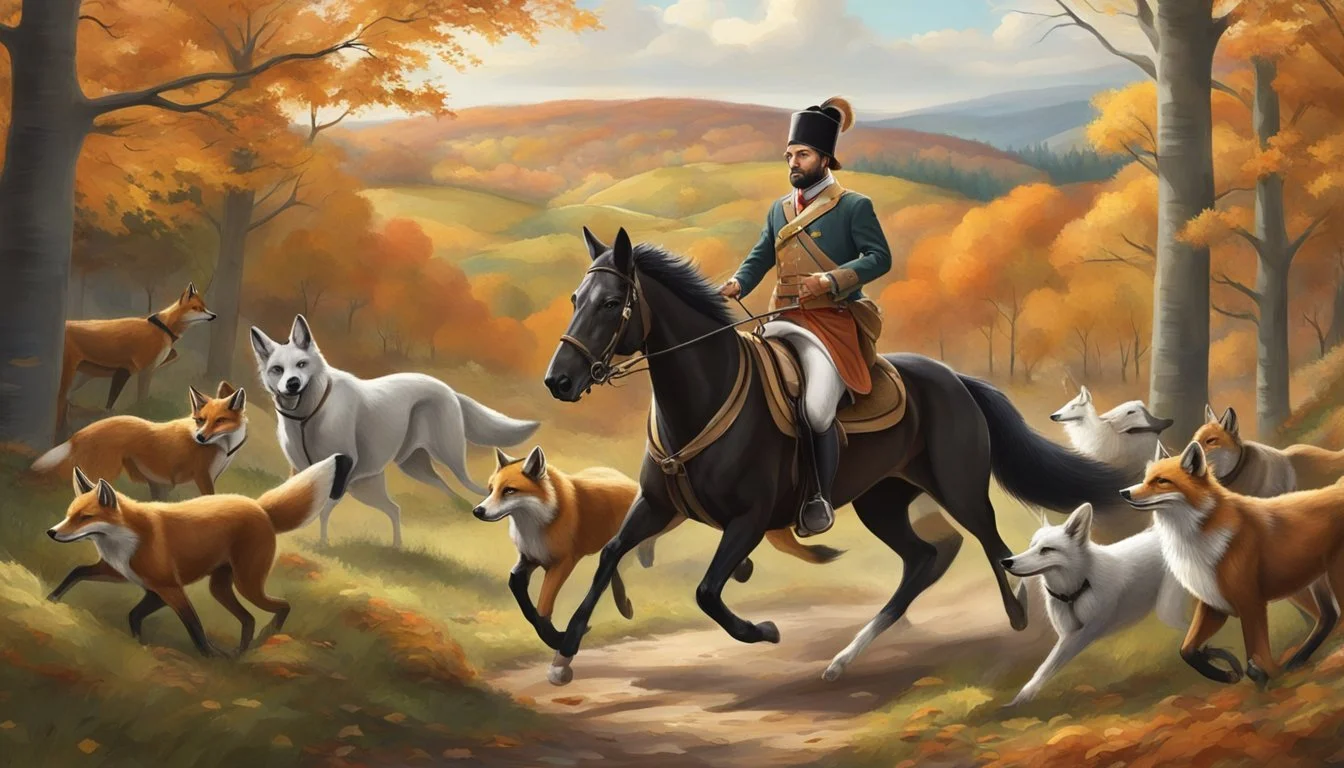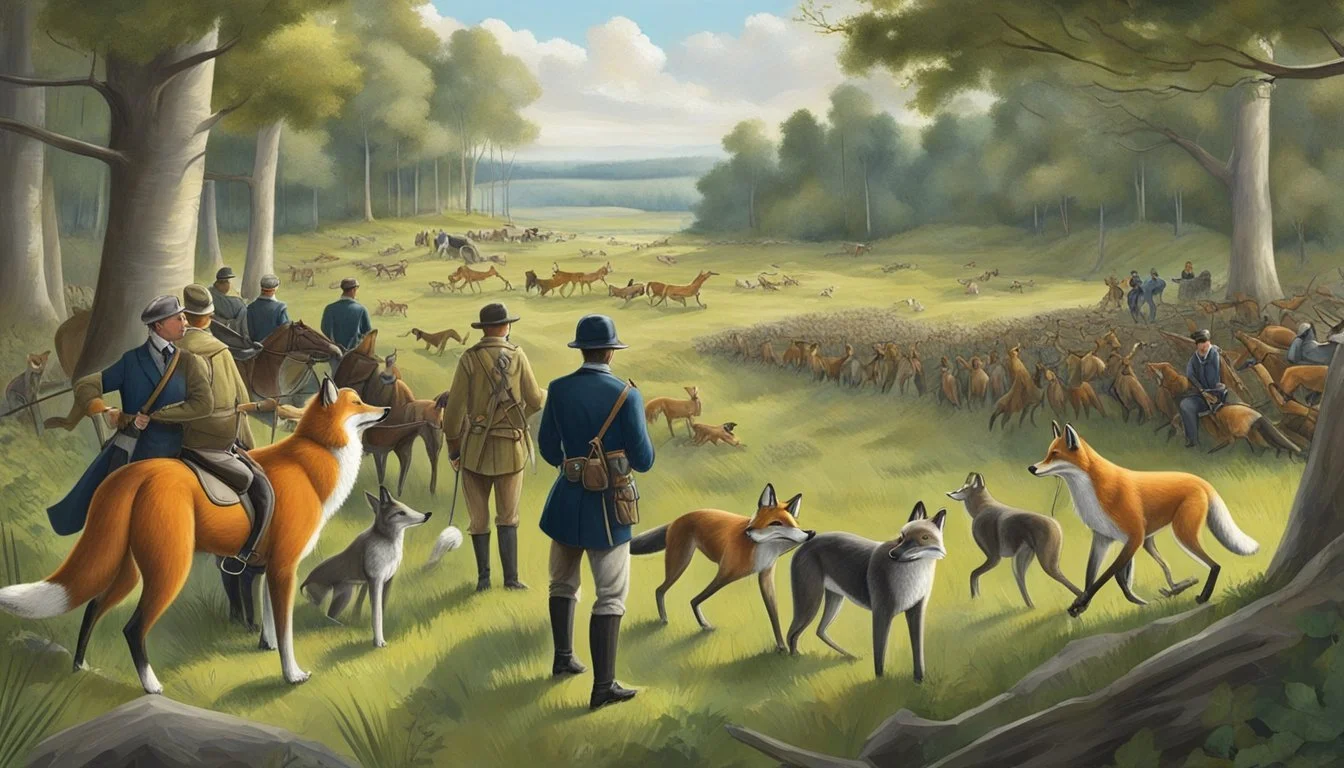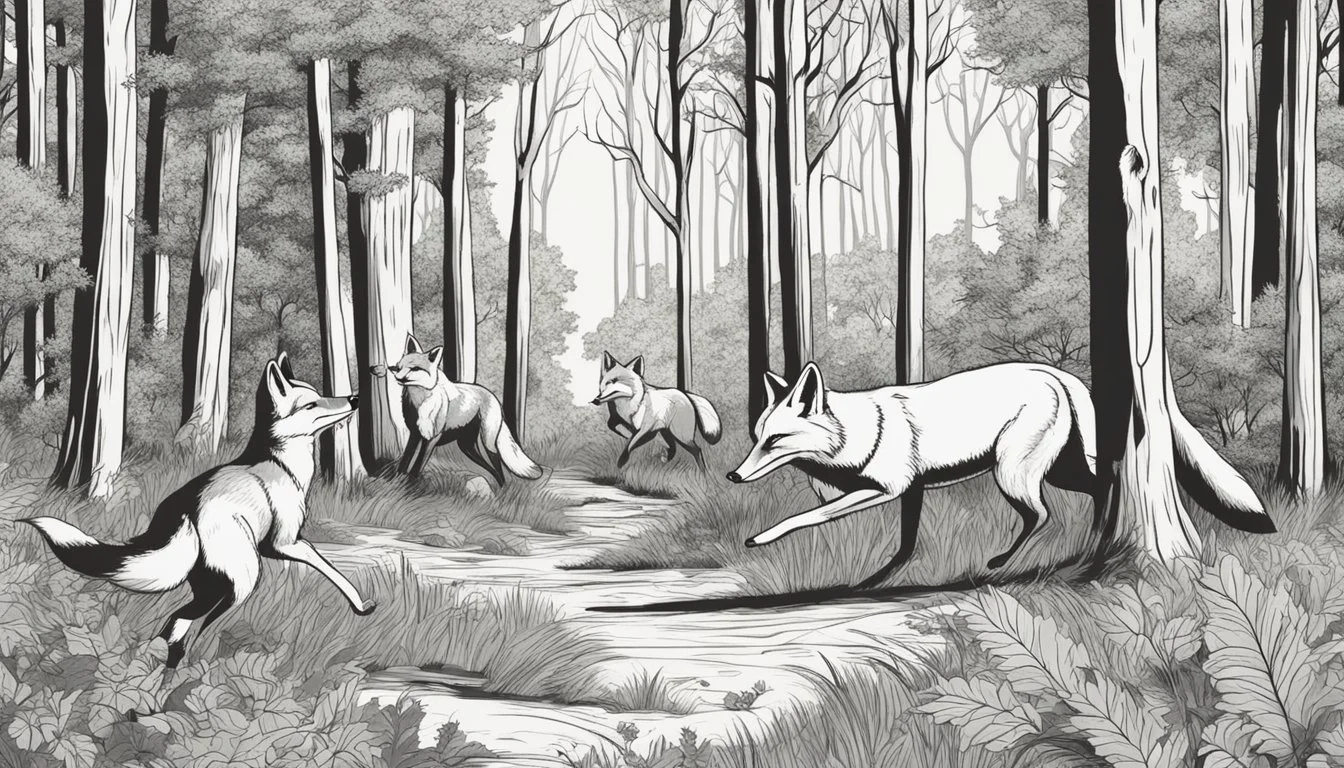Fox Hunting Seasons
Regulations and Dates Across Regions
This Article is Part of Our Guide on Hunting Seasons for Over 70 Common Game Species
Fox hunting, a tradition with ancient origins, is an activity that varies widely in practice and regulation across different states in the United States. Historically, hunting with hounds was a method for tracking prey dating back to the time of the Assyrians, Babylonians, and ancient Egyptians. Today, the modern incarnation of fox hunting involves pursuing foxes with the aid of trained hounds and often on horseback, combining elements of outdoor sport, social ritual, and wildlife management. Yet, this practice has been met with an array of regulations reflecting contemporary concerns about animal welfare and conservation.
In the U.S., each state determines its own hunting seasons and regulations, with some states permitting fox hunting under strict guidelines while others have imposed bans. For example, states like California, Colorado, and New York have outlawed the practice, whereas others set specific seasons and dates when fox hunting can legally occur. These regulated hunting periods are designed to balance the interests of hunters with the conservation efforts necessary to maintain healthy fox populations and preserve the ecosystems they inhabit.
Hunters interested in participating in fox hunting must familiarize themselves with local laws and regulations, which not only dictate legal hunting seasons but also hunting methods, bag limits, and the use of hunting lands—both public and private. Conservation measures are often integrated into these regulations to ensure sustainable hunting practices. Moreover, hunters are generally required to obtain the appropriate licenses and are encouraged to stay informed about any changes in hunting regulations, as these can be subject to annual adjustments by wildlife management authorities.
History and Origins of Fox Hunting
Tracing the roots of fox hunting involves a journey through time from ancient traditions of chasing wildlife to the structured hunts that became a symbol of status in British culture. It's a practice that has evolved over centuries, shaping not only local customs but also influencing societies across the ocean.
Fox Hunting in North America
Fox hunting was introduced to North America by European settlers, and it quickly became an established sport amongst the colonies. George Washington himself was known to be an avid fox hunter, maintaining his own pack of trained foxhounds. In North America, the sport initially served a dual purpose of recreation and pest control, targeting both the red fox and the grey fox, which were considered threats to livestock.
17th Century: Fox hunting as a structured activity makes its way to the colonies.
George Washington: A key historical figure in early American fox hunting.
As settlements expanded, the sport also became a social event, symbolizing communal gatherings and shared interests among the gentry. The position of Master of Foxhounds was established, indicating the person responsible for the maintenance and care of the pack, as well as for overseeing the conduct of the hunt itself.
British Influence and Traditions
The influence of British traditions on fox hunting is significant and enduring. The ritualized form of the hunt, with its strict roles, dress, and procedures, originated in the English countryside. From pest control, it transformed into a pursuit associated with the upper classes, embodying a sense of tradition and social standing.
18th & 19th Centuries: Formalization of fox hunting in Britain.
British Culture: Develops strict codes of conduct and attire for the hunt.
In the UK, specifically, fox hunting became more organized and selective, with the breeding of foxhounds tailored to increase their efficiency in the chase. By the 19th century, fox hunting had cemented its place in British culture, often reflecting one's social position and becoming a mainstay of rural life.
Hunting Seasons Overview
The hunting seasons are intricately planned to ensure sustainable wildlife management and to provide hunters with clear guidelines. These seasons are often determined by species and method of take to allow for effective population control and conservation efforts.
General Season Dates
Fall: Traditionally, fall marks the start of the general hunting season, especially for popular game like deer.
Season Dates: These vary by state and even within different regions of a state to accommodate local wildlife populations and migratory patterns.
Deer
Archery Season: Typically opens in early fall and can extend into late fall or early winter.
Muzzleloader: Often follows the archery season and provides a limited window for hunters using these specific firearms.
Species-Specific Seasons
Migratory Birds: Includes ducks and geese, with the season dates usually established in accordance with federal frameworks and often split to allow hunting during peak migrations.
Wild Turkey: Spring and fall seasons vary by state, with some states offering both and others only one season annually.
Waterfowl: Season dates are typically aligned with the migratory patterns of ducks and geese to reduce impact on the populations during nesting and rearing times.
It is important for hunters to refer to the latest state regulations for precise dates and specific hunting regulations to ensure compliance and conservation.
Legal Regulations and Conservation
The legal framework of fox hunting involves a complex interplay of state and federal guidelines, conservation principles, and ethical considerations. Regulations are in place to balance the practice of hunting with animal welfare and conservation efforts.
State and Federal Guidelines
State regulations for fox hunting vary significantly, with some states allowing the practice under strict conditions while others impose outright bans. For example, some states may delineate specific hunting seasons whereas others may regulate the types of permissible traps to ensure humane treatment. Federal laws may oversee hunting practices that impact multiple states or relate to wider environmental and conservation concerns.
Federal agencies also mandate sustainable hunting practices to prevent the overhunting of fox populations. They establish guidelines that hunters must follow to minimize the impact on local ecosystems and to support the conservation of the species.
Ethical Considerations
The ethics of fox hunting involve both animal welfare considerations and sustainable hunting practices. Ethical hunters are expected to follow guidelines that reduce suffering and abide by the principle of conservation. They are encouraged to engage in practices that ensure a healthy fox population continues to thrive. These considerations are not only crucial for maintaining biodiversity but also for preserving the natural heritage associated with fox hunting.
Each hunter's adherence to these ethical considerations ultimately affects public perception of the sport and its future legal status. To support this, many hunting communities and conservation groups work together to promote education on responsible hunting.
Hunting Techniques and Practices
In pursuing foxes, hunters employ a variety of methods including the use of dogs, horseback hunting, and more modern techniques involving firearms and archery. These time-honored practices require skill, knowledge of fox behavior, and a strict adherence to legal and ethical guidelines.
Using Dogs in Fox Hunting
Fox hunting with dogs typically involves a pack of hounds, often foxhounds, trained to pick up the scent of a fox and pursue it. The hunters, also known as the field, follow the hounds:
Scent tracking: Hounds use their keen sense of smell to track the fox's path.
Hound management: Hunters are responsible for managing the pack, ensuring the dogs are well-trained and respond to hunting commands.
Hunters on Horseback
Horseback hunters accompany the hounds, navigating varied terrain to keep up with the chase:
Equestrian skills: Riders must possess competent horsemanship to handle the fast pace and potential obstacles.
Coordination with dogs: They work in tandem with their canine counterparts, interpreting the pack's movement to anticipate the fox's location.
Firearms and Archery
While traditional fox hunting relies on dogs and horseback, many hunters now use firearms or archery equipment to hunt foxes:
Firearm types: Hunters may opt for a variety of firearms, including rifles, shotguns, and, in some places, muzzleloading guns, each suitable for different hunting scenarios.
Archery gear: Hunters using a bow may choose between a modern compound bow or a traditional recurve, with crossbows also being a choice in certain regions.
Precision and practice: Success with firearms and archery relies on precise shooting skills, which are honed with practice and a thorough understanding of the equipment.
Each of these techniques requires thorough preparation, understanding of the local wildlife regulations, and a commitment to sustainable hunting practices.
Fox Species and Recognizing Tracks
The proper identification of fox species and their tracks is crucial for successful hunting practices and wildlife observation. Recognizing the subtle differences among species and their signs in various terrains enhances a hunter's or observer's tracking proficiency.
Types of Foxes
Foxes belong to several species, but two prevalent ones in North America are the red fox (Vulpes vulpes) and the grey fox (Urocyon cinereoargenteus). The red fox is renowned for its bright, rusty red coat, while the grey fox is distinguished by its distinct grey fur with hints of red.
Red Fox:
Size: Larger than the grey fox
Range: Found throughout the Northern Hemisphere
Grey Fox:
Size: Slightly smaller with shorter legs
Range: Native to North America and found in various habitats
Each species adapts to its environment, affecting their respective hunting grounds and behaviors.
Tracking and Signs
Successful tracking of foxes relies on understanding their physical tracks and other signs they leave in their habitat.
Fox Tracks: Identification of fox tracks can vary slightly between species but share common characteristics:
Shape: Oval or diamond-shaped
Size: Approximately 1.5-2.5 inches in length and 1.5-2 inches in width
Structure: Four toe pads and a larger heel pad; claw marks may be present
Tracking by Terrain: Foxes frequent diverse terrains, and their tracks may appear differently based on the hunting ground:
Terrain Track Visibility Snow Highly visible: clear imprints with visible fur marks Mud Distinct: the wet ground captures fine details Dry Ground Less Visible: look for patterns disturbed soil or faint indentations
Foxes rely heavily on their keen sense of smell, leaving behind scents that can be tracked by trained hunting dogs. Hunters often employ this technique in combination with visual tracking for precise localization of foxes.
Equipment and Gear
When engaging in fox hunting, one must ensure they have the appropriate clothing and tools, which are pivotal for both utility and adherence to hunting traditions.
Clothing and Footwear
For attire, hunters typically wear breeches, boots, and hunting jackets that are functional for moving across different terrains. Here's a quick breakdown of fox hunting apparel:
Item Description Breeches Durable and allow for mobility Boots Sturdy, with sufficient tread for grip Jackets Traditionally colored and made for the weather conditions
Gender, season, and regional customs also influence the clothing selection, with formal attire being reserved for certain times and informal dress for others.
Tools for the Hunt
Hunters equip themselves with a variety of tools that range from tracking aids to hunting weapons. Here's a brief list of gear often involved in fox hunting:
Maps and GPS: Vital for navigation through various hunting terrains.
Mobile Apps: Used for real-time updates and tracking.
Rifles and Shotguns: Depending on the location and hunting laws, different firearms may be used legally.
Bait: While not always used, it can be an important component in certain hunting strategies.
Each piece of gear serves a strategic purpose, and hunters must be familiar with the operation and legalities of their equipment.
Wildlife and Ecosystem Impact
Foxes' Role in the Ecosystem
The fox is a keystone species, meaning its presence has a disproportionately large effect on its ecosystem. Foxes regulate the populations of small mammals and birds, such as squirrels, pheasants, and quail (What wine goes well with quail?), contributing to a balanced ecosystem.
Impact on Other Wildlife
Fox hunting can have a cascading effect on the ecosystem. The absence or decrease of fox populations can lead to an increased number of small mammals and birds, which can then affect the vegetation and food sources for other wildlife, including deer, elk, and opossums. Conversely, these altered conditions can also attract species like coyotes and badgers, which may step in to fill the predatory role left by foxes.
Hunting Licenses and Permits
Acquiring the appropriate license or permit is a critical initial step for anyone seeking to engage in fox hunting. Regulations vary by state, and hunters should ensure they are fully compliant with local laws.
Requirements and Applications
To hunt foxes, individuals must possess the relevant hunting license or permit. Residents typically need a state-issued license, while non-residents may require a specific non-resident permit. Applications for these licenses are often available as PDF documents on the respective state’s Department of Environmental Conservation (DEC) website or through online licensing systems where hunters can subscribe for updates.
Resident License Requirements:
Proof of residency
Payment of license fee
Non-Resident License Requirements:
Identification
Applicable non-resident fee
Applications should be submitted prior to the hunting season to allow sufficient processing time.
Education and Certification
Before issuing a license, many states mandate that hunters complete an education course. This often includes a focus on safety, ethics, and wildlife conservation.
Education Course Requirements:
Attendance
Completion of examination
Certification from such a course is typically a prerequisite for a first-time hunting license. Hunters may find resources and coursework through online platforms or in-person classes offered by state wildlife agencies.
Additional Hunting Opportunities
Hunters seeking additional game beyond fox can find a variety of seasons and species to pursue. Each category has distinct regulations to ensure sustainable wildlife populations and ethical hunting practices.
Small Game and Upland Birds
Small game and upland bird hunting presents opportunities for those interested in species like woodcock, ruffed grouse, sharp-tailed grouse, cottontail, and jackrabbit. For instance, woodcock seasons typically coincide with their migratory patterns in the fall. Grouse seasons vary by state, with many northern locales offering prime habitat for these game birds.
Cottontail and jackrabbit seasons often span several months, providing extensive opportunities across various states.
Turkey hunters can pursue wild turkey during designated spring and fall seasons, as these birds provide a challenge and reward for skilled hunters.
Waterfowl and Migratory Species
Waterfowl and migratory bird hunting is regulated at both the federal and state level to protect populations and their migrations.
Seasons for early teal, snipe, and coot are especially popular in areas where migration corridors provide ample hunting.
Migratory birds including ducks and geese have detailed regulations including specific bag limits and hunting zones, which are often detailed in state-published summaries.
Public lands are critical for these hunting opportunities, offering access for various game species. Hunters participating in falconry also have designated seasons that often extend beyond regular gun hunting dates. Regulations for these practices ensure the pursuit does not negatively impact raptor or prey populations.
For each species, hunters must follow specific guidelines, such as bag limits and permitted hunting methods. These measures help maintain the balance of ecosystems and promote conservation.





